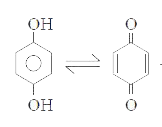Given the following half- cell : YI+e−→Y+I−,E∘=−0.27V
Solubility product of the iodide salt YI is
2×10−3
2×10−12
2×10−14
6.8×10−16
The correct Answer is:C
To find the solubility product (Ksp) of the iodide salt YI given the half-cell reaction and its standard electrode potential, we can follow these steps:
1. Write the Half-Cell Reaction:
The half-cell reaction is given as:
YI+e−→Y+I−
The standard electrode potential (E°) for this reaction is -0.27 V.
2. Determine the Overall Reaction:
The overall reaction for the dissolution of YI can be represented as:
YI⇌Y++I−
3. Relate the Electrode Potential to Gibbs Free Energy:
The relationship between the Gibbs free energy change (ΔG°) and the standard electrode potential (E°) is given by the equation:
ΔG°=−nFE°
where:
- n = number of moles of electrons transferred (1 for this reaction),
- F = Faraday's constant (approximately 96485 C/mol),
- E° = standard electrode potential.
4. Calculate ΔG°:
Substituting the values into the equation:
ΔG°=−1×96485×(−0.27)=26010.45J/mol
5. Relate ΔG° to Ksp:
The relationship between ΔG° and the solubility product (Ksp) is given by:
ΔG°=−RTlnKsp
where R is the universal gas constant (8.314 J/(mol·K)) and T is the temperature in Kelvin (assume 298 K for standard conditions).
6. Rearranging for Ksp:
Rearranging the equation gives:
Ksp=e−ΔG°/(RT)
7. Substituting Values:
Substitute ΔG°, R, and T into the equation:
Ksp=e−26010.45/(8.314×298)
Calculate the exponent:
Ksp=e−10.49≈2.0×10−5
8. Final Calculation:
The Ksp value can be approximated as:
Ksp≈2×10−14
Conclusion:
The solubility product (Ksp) of the iodide salt YI is approximately 2×10−14.
The half-cell reaction is given as:
YI+e−→Y+I−
The standard electrode potential (E°) for this reaction is -0.27 V.
The overall reaction for the dissolution of YI can be represented as:
YI⇌Y++I−
The relationship between the Gibbs free energy change (ΔG°) and the standard electrode potential (E°) is given by the equation:
ΔG°=−nFE°
where:
- n = number of moles of electrons transferred (1 for this reaction),
- F = Faraday's constant (approximately 96485 C/mol),
- E° = standard electrode potential.
Substituting the values into the equation:
ΔG°=−1×96485×(−0.27)=26010.45J/mol
The relationship between ΔG° and the solubility product (Ksp) is given by:
ΔG°=−RTlnKsp
where R is the universal gas constant (8.314 J/(mol·K)) and T is the temperature in Kelvin (assume 298 K for standard conditions).
Rearranging the equation gives:
Ksp=e−ΔG°/(RT)
Substitute ΔG°, R, and T into the equation:
Ksp=e−26010.45/(8.314×298)
Calculate the exponent:
Ksp=e−10.49≈2.0×10−5
The Ksp value can be approximated as:
Ksp≈2×10−14
The solubility product (Ksp) of the iodide salt YI is approximately 2×10−14.
Topper's Solved these Questions
- ELECTROCHEMISTRYBOOK - VMC MODULES ENGLISHCHAPTER - ELECTROCHEMISTRYEXERCISE - JEE Main (Archive)
57 Videos
- ELECTROCHEMISTRYBOOK - VMC MODULES ENGLISHCHAPTER - ELECTROCHEMISTRYEXERCISE - JEE Advanced (Archive)
76 Videos
- ELECTROCHEMISTRYBOOK - VMC MODULES ENGLISHCHAPTER - ELECTROCHEMISTRYEXERCISE - Level-1
75 Videos
- CLASSIFICATION OF ELEMENTS AND PERIODICITY IN PROPERTIES BOOK - VMC MODULES ENGLISHCHAPTER - CLASSIFICATION OF ELEMENTS AND PERIODICITY IN PROPERTIES EXERCISE - JEE ADVANCE (ARCHIVE)
30 Videos
- ENVIRONMENTAL CHEMISTRYBOOK - VMC MODULES ENGLISHCHAPTER - ENVIRONMENTAL CHEMISTRYEXERCISE - JEE Main (Archive)
39 Videos
Similar Questions
The magnitude ( but not the sign ) of the standard reduction potentials of two metals X and Y are :
Y2+2e−→Y∣∣Ec−1∣∣=0.34V
X2+2e−→X∣∣Ec−2∣∣=0.25V
When the two half cells of X and Yare connected to construct a cell, eletrons flow from X to Y. When X is connected to a standard hydrogen electrode (SHE),electrons flow from X to SHE.
Given the following half cell :YI+e−→Y−Ic−: Ec−=−0.27V
Solubility product of the iodide salt YI is
View SolutionThe magnitude ( but not the sign ) of the standard reduction potentials of two metals X and Y are :
Y2+2e−→Y∣∣Ec−1∣∣=0.34V
X2+2e−→X∣∣Ec−2∣∣=0.25V
When the two half cells of X and Yare connected to construct a cell, eletrons flow from X to Y. When X is connected to a standard hydrogen electrode (SHE),electrons flow from X to SHE.
Given the following half cell :YI+e−→Y+I−: Ec−=−0.27V
Solubility product of the iodide salt YI is
(a)2×10−3
(b)2×10−12
(c)2×10−14
(d)6.8×10−16
View Solution
Knowledge Check
Which of the following is the cell reaction that occurs when the following half-cells are combined?
I2+2e−→2I−(1M),E∘=+0.54V
Br2+2e−→2Br(1M),E∘=+1.09VA2Br−+I2→Br2+2I−BI2+Br2→2I−+2Br−C2I−+Br2→I2+2Br−D2I−+2Br−→I2+Br2
From the following Eo value of helf cells:
(i) A+e−→A−,Eo=−0.824V
(ii) B−+e−→B2−,Eo=+1.25V
(iii) C−+2e−→C3−,Eo=−1.25V
(iv) D−+2e−→D2−,Eo=+0.68V
What combination of two half cells would result is a cell with the largest cell potential?
View SolutionGiven :
Co3++e−→Co2+ , E∘=+1.81V
pb4++2e−→Pb2+ , E∘=+1.67V
Ce4+e−→Ce3+,E∘=+1.61V
Ce4+3e−→Bi, E∘=+0.20V
Oxidation power of the species will increase in the order:
View SolutionThe standard reduction potentials at 298K for the following half cells are given :
ZN2+(aq)+2e−Zn(s), E∘=−0.762V
Cr3+(aq)+3e−Cr(s), E∘=−0.740V
2H+(aq)+2e−H2(g), E∘=0.000V
Fe3+(aq)+e−Fe2+(aq), E∘=0.770V
which is the strongest reducing agent ?
View SolutionThe standard oxidation potentials, , for the half reactions are as follows :
Zn→Zn2++2e− ,E∘=+0.76V
Fe→Fe2++2e−,E∘=+0.41V
The EMF for the cell reaction,
Fe2++Zn→Zn2++Fe
View SolutionFor the half cell,

+2H+2e−.E0=
1.30 V. At pH=2, electrode potential of the given quinhydrone half cell is :
View SolutionA13++3e−→Al(s), E∘=−1.66V
Cu2++2e−→CU(s), E∘=+0.34V
What voltage is produced under standard conditions by combining the half reactions with these standard electrode potentials?
View SolutionGiven :
Hg2+2→2Hg, E∘=0.789V and Hg2++2e−→Hg, E∘=0.854V
Calculate the equilibrium consant for Hg2+2→Hg+Hg2+.
View Solution
